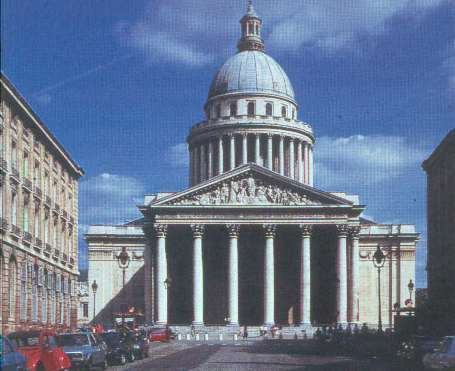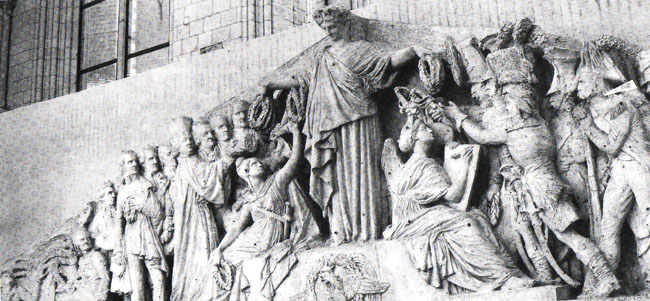The Pantheon, Paris

The old church of Sainte-Genevieve, patron of Paris, had been allowed to fall into ruins. When Louis XV was ill, he promised Mme. Pompadour that if he recovered, he would build her a new church. The new building was designed by Souflot and begun in 1764.
Although the function and decor of the building has changed many times, it has essentially served as a burial spot for the heroes of France since 1791, when the Revolutionary government made it a mausoleum. Among those buried there are Voltaire, Rousseau, Marat, and Victor Hugo, Soufflot and the mathematician Lagrange.
It was in 1830 that David d'Angers received the important commission for the grand 129 foot pediment (fronton) from Louis-Philippe, who approved the patriotic and high-minded politics of the artist. The inscription across the front: AUX GRAND HOMMES, LA PATRIE RECONNAISSANTE (To great men, from a grateful Country). All of the various stages of David's project are found in the Angers museum, from sketches to a one-third scale model.
At the center of the pediment is found the allegorical figure of La France, dispensing wreaths of immortality on the worthies. At her feet are the figure of History (right, writing the names of the generals Kléber and Hoche in her book) and a Phrygian-capped image of the Republic (left, handing her the wreaths). Grouped to the right are military figures, all of anonymous Revolutionary soldiers led by the young Napoleon. To the left are men of science, politics and art, including Malesherbes, lawyer to Louis XVI, Revolutionary figures Mirabeau, Monge and Fénelon (an example of religious tolerance). Behind are politicians Manuel and Carnot, the chemist Berthollet and mathemtician Laplace. In the back the painter Jacques-Louis David, who recorded so many scenes of the Revolution, the naturalist Cuvier and General Lafayette. Behind these are the two great thinkers of the 18th century Voltaire and Rousseau. In both corners of the triangular pediment are depicted students from the Ecole Polytechnique, presumably learning from the glorious examples before them.
David d'Angers' choices among men of thought and action were surprising to some (only one general!), perhaps the reason that the project was suspended for four years. The sculpture was completed in 1837, but unveiled without ceremony because of the controversy in a political milieu quite changed from the time of the original commission.

- Sources of images: CUA Digital Media exhibit
and Parisrama.
 Return to
Return to
